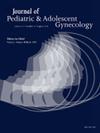9. Hemostatic efficacy of norethindrone acetate versus IV conjugated estrogen for adolescents presenting to the emergency room with heavy menstrual bleeding
IF 1.7
4区 医学
Q3 OBSTETRICS & GYNECOLOGY
引用次数: 0
Abstract
Background
Heavy menstrual bleeding (HMB) is a common complaint among adolescent females, but standardized guidelines for first line treatment agents are lacking in this population. A clinical pathway was developed in 2017 utilizing intravenous (IV) conjugated estrogen for acute HMB. To reduce costs and transition to oral therapy, a 2019 pathway was adapted to use oral norethindrone acetate (NA) for most patients versus IV conjugated estrogen. This study compares hemostatic efficacy of NA versus IV conjugated estrogen among adolescents with acute HMB.
Methods
A retrospective chart review was performed including all emergency department (ED) encounters at a tertiary children's hospital and affiliates which utilized a clinical pathway between treatment period 1 (02/01/17- 12/31/19) and 2 (01/01/21-12/31/22; excluding 2020 due to impact of COVID-19 pandemic). Demographics, laboratory tests, and treatment outcomes were collected. Hemostatic efficacy was defined as follows: length of stay (LOS), red blood cell (RBC) transfusion, tranexamic acid (TXA) utilization and menstrual suppression at 90 and 180 days. Per protocol, TXA was added if HMB persisted after 24 hours of a primary agent. T tests and chi squared statistics compared continuous and categorical variables, respectively. Multivariate logistic regression models predicted adjusted odds ratios of outcome variables (NA vs. IV conjugated estrogen), controlling for hemoglobin and treatment period.
Results
Between 2017-2022, 787 adolescents presented to the ED for HMB. Over half (n=402, 58.2%) were admitted and had BMI measurements, of which 126 (31.3%) received NA as primary therapy and 208 (51.7%) received IV conjugated estrogen. Receiving NA alone was associated with shorter LOS (p< 0.001), fewer RBC transfusions (p=0.005) and lower TXA utilization (p=0.009) relative to receiving IV conjugated estrogen. In multivariate logistic regression, when controlling for hemoglobin and treatment period, receiving NA alone was associated with lower odds of RBC transfusion (AOR: 0.391, 95% CI: 0.182-0.838, p=0.016) and TXA utilization (AOR: 0.268, 95% CI: 0.105-0.682; p=0.006) relative to IV conjugated estrogen. We observed no significant differences in adjusted odds of LOS >36 hours, or menstrual suppression at 90- and 180-day follow-up visits by hemostatic agent.
Conclusions
Among adolescents with acute HMB, receiving NA was associated with reduced odds of RBC transfusion and TXA utilization relative to receiving IV conjugated estrogen. NA may offer a more cost-effective option with comparable efficacy for acute HMB in adolescents.
9. 醋酸去甲thindrone与静脉结合雌激素对因大量月经出血而进入急诊室的青少年的止血效果比较
背景:大量月经出血(HMB)是青春期女性的常见症状,但在这一人群中缺乏一线治疗药物的标准化指南。2017年,利用静脉(IV)结合雌激素治疗急性HMB的临床途径被开发出来。为了降低成本并过渡到口服治疗,2019年的途径被调整为对大多数患者使用口服醋酸去甲thindrone (NA)而不是静脉结合雌激素。本研究比较了NA与静脉结合雌激素在青少年急性HMB患者中的止血效果。方法回顾性分析某三级儿童医院及其附属医院在治疗期1(02/01/17- 12/31/19)和治疗期2(01/01/21-12/31/22)之间的所有急诊科(ED)就诊情况;由于COVID-19大流行的影响,不包括2020年)。收集人口统计、实验室检查和治疗结果。止血疗效的定义如下:90和180天的住院时间(LOS)、红细胞(RBC)输注、氨甲环酸(TXA)的使用和月经抑制。根据协议,如果HMB在主用药24小时后仍然存在,则添加TXA。T检验和卡方统计分别比较连续变量和分类变量。多变量logistic回归模型预测调整后的结果变量(NA vs. IV结合雌激素)的优势比,控制血红蛋白和治疗时间。结果2017-2022年间,共有787名青少年因HMB就诊。超过一半(n=402, 58.2%)的患者入院并进行BMI测量,其中126例(31.3%)接受NA作为主要治疗,208例(51.7%)接受静脉结合雌激素治疗。单独接受NA与较短的LOS (p<;0.001),相对于静脉结合雌激素,红细胞输注量减少(p=0.005)和TXA利用率降低(p=0.009)。在多因素logistic回归中,在控制血红蛋白和治疗时间的情况下,单独接受NA治疗与较低的RBC输血几率(AOR: 0.391, 95% CI: 0.182-0.838, p=0.016)和TXA利用率(AOR: 0.268, 95% CI: 0.105-0.682;p=0.006)。我们观察到,止血药物在随访90天和180天时,36小时LOS或月经抑制的调整几率无显著差异。结论在青少年急性HMB患者中,相对于静脉结合雌激素,接受NA可降低红细胞输血和TXA利用的几率。NA可能为青少年急性HMB患者提供更具成本效益的选择,且疗效相当。
本文章由计算机程序翻译,如有差异,请以英文原文为准。
求助全文
约1分钟内获得全文
求助全文
来源期刊
CiteScore
3.90
自引率
11.10%
发文量
251
审稿时长
57 days
期刊介绍:
Journal of Pediatric and Adolescent Gynecology includes all aspects of clinical and basic science research in pediatric and adolescent gynecology. The Journal draws on expertise from a variety of disciplines including pediatrics, obstetrics and gynecology, reproduction and gynecology, reproductive and pediatric endocrinology, genetics, and molecular biology.
The Journal of Pediatric and Adolescent Gynecology features original studies, review articles, book and literature reviews, letters to the editor, and communications in brief. It is an essential resource for the libraries of OB/GYN specialists, as well as pediatricians and primary care physicians.

 求助内容:
求助内容: 应助结果提醒方式:
应助结果提醒方式:


